

Feedly Mini – Adoptez cette extension pour □ Firefox (fr) Extensions Registry. Installation et premiers pas - Créez vos applications web avec Flask. FreeHosts. Handle a POST Request In Flask for Python Code Example. AJAX with jQuery — Flask Documentation (0.10) jQuery is a small JavaScript library commonly used to simplify working with the DOM and JavaScript in general.
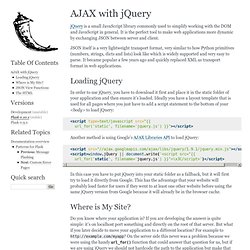
It is the perfect tool to make web applications more dynamic by exchanging JSON between server and client. JSON itself is a very lightweight transport format, very similar to how Python primitives (numbers, strings, dicts and lists) look like which is widely supported and very easy to parse. It became popular a few years ago and quickly replaced XML as transport format in web applications. Loading jQuery In order to use jQuery, you have to download it first and place it in the static folder of your application and then ensure it’s loaded. Another method is using Google’s AJAX Libraries API to load jQuery:
How To Serve Flask Applications with Gunicorn and Nginx on Ubuntu. Introduction In this guide, you will build a Python application using the Flask microframework on Ubuntu 18.04.
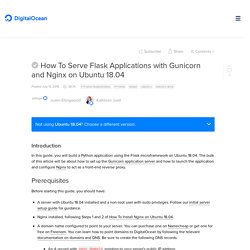
The bulk of this article will be about how to set up the Gunicorn application server and how to launch the application and configure Nginx to act as a front-end reverse proxy. Prerequisites Before starting this guide, you should have: A server with Ubuntu 18.04 installed and a non-root user with sudo privileges. Step 1 — Installing the Components from the Ubuntu Repositories Our first step will be to install all of the pieces we need from the Ubuntu repositories.
First, let's update the local package index and install the packages that will allow us to build our Python environment. Sudo apt update sudo apt install python3-pip python3-dev build-essential libssl-dev libffi-dev python3-setuptools With these packages in place, let's move on to creating a virtual environment for our project. Standalone WSGI Containers — Flask 0.12.4 documentation. There are popular servers written in Python that contain WSGI applications and serve HTTP.

These servers stand alone when they run; you can proxy to them from your web server. Note the section on Proxy Setups if you run into issues. Gunicorn. Configure Python 3, Flask and Gunicorn on Ubuntu 18.04 LTS. Ubuntu Linux's latest Long Term Support (LTS) operating system version is 18.04 and was released in April 2018.

The 18.04 update is code named "Bionic Beaver" and it includes Python 3 by default. However, there are bunch of dependencies you will need to install to get this release set up as a development environment. Initiation au Machine Learning avec Python - La théorie. Tutoriel en 2 parties: Introduction. Python : Bien configurer son environnement de développement. C'est quand même plus sympa de développer quand notre environnement de développement est bien configuré !

Ce didacticiel est une introduction à quelques bonnes pratiques qui vous permettront d'avoir un environnement de développement Python aux petits oignons : Travailler avec des environnements virtuels et les associer aux projets,Personnaliser le script de démarrage du shell Python,Valider son code Python,Standardiser l'exécution des tests. Flask Biography Tutorial. The Flask Mega-Tutorial, Part I: Hello, World! This is the first article in a series where I will be documenting my experience writing web applications in Python using the Flask microframework.

NOTE: This article was revised in September 2014 to be in sync with current versions of Python and Flask. Here is an index of all the articles in the series that have been published to date: My background I'm a software engineer with double digit years of experience developing complex applications in several languages. I first learned Python as part of an effort to create bindings for a C++ library at work. In addition to Python, I've written web apps in PHP, Ruby, Smalltalk and believe it or not, also in C++. Python Flask and jQuery Ajax POST. I have already covered an introductory article on getting started with python web application development using Python Flask and MySQL.
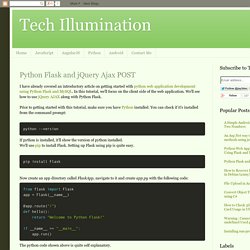
In this tutorial, we'll focus on the client side of the web application. We'll see how to use jQuery AJAX along with Python Flask. Prior to getting started with this tutorial, make sure you have Python installed. You can check if it's installed from the command prompt: How to automatically create a form from a model in Flask. I’ve been playing around a bit with a Python microframework called Flask lately.
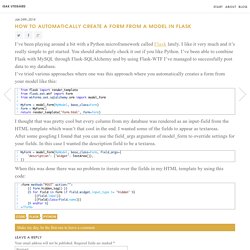
I like it very much and it’s really simple to get started. You should absolutely check it out if you like Python. I’ve been able to combine Flask with MySQL through Flask-SQLAlchemy and by using Flask-WTF I’ve managed to successfully post data to my database. I’ve tried various approaches where one was this approach where you automatically creates a form from your model like this: Facebook Authentication for Flask Apps. Ok, it looks like you want to add Facebook login to your Flask app.
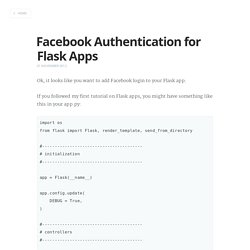
If you followed my first tutorial on Flask apps, you might have something like this in your app.py: import os from flask import Flask, render_template, send_from_directory #---------------------------------------- # initialization #---------------------------------------- app = Flask(__name__) app.config.update( DEBUG = True, ) #---------------------------------------- # controllers #---------------------------------------- @app.route('/favicon.ico') def favicon(): return send_from_directory(os.path.join(app.root_path, 'static'), 'ico/favicon.ico') @app.errorhandler(404) def page_not_found(e): return render_template('404.html'), 404 @app.route("/") def index(): return render_template('index.html') #---------------------------------------- # launch #---------------------------------------- if __name__ == "__main__": port = int(os.environ.get("PORT", 5000)) app.run(host='0.0.0.0', port=port) register your app on Facebook.
Lightweight Python Apps with Flask, Bootstrap, and Heroku. Welcome!
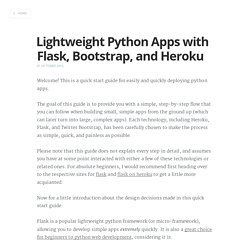
This is a quick start guide for easily and quickly deploying python apps. The goal of this guide is to provide you with a simple, step-by-step flow that you can follow when building small, simple apps from the ground up (which can later turn into large, complex apps). Each technology, including Heroku, Flask, and Twitter Bootstrap, has been carefully chosen to make the process as simple, quick, and painless as possible. Please note that this guide does not explain every step in detail, and assumes you have at some point interacted with either a few of these technologies or related ones. For absolute beginners, I would recommend first heading over to the respective sites for flask and flask on heroku to get a little more acquianted.
Now for a little introduction about the design decisions made in this quick start guide: Créez vos applications web avec Flask. Version en ligne Table des matières Créez vos applications web avec Flask Vous avez appris le Python et aimeriez l’utiliser pour créer votre site web ? C’est possible ! Le langage Python est tout à fait adapté pour cela, et de nombreux frameworks peuvent vous simplifier la tâche. :) Je vous propose de découvrir l’un d’entre eux, Flask, qui a l'avantage d'être très simple à prendre en main. Ce tutoriel est accessible aux débutants, mais demande tout de même quelques pré-requis : Https with Http in Flask Python. Pyramidologie - Qwant Recherche. L'interprétation des rêves - La signification de votre rêve. La Grande Pyramide et le Sphinx (1) La grande pyramide de Kheops est la dernière des 7 merveilles du monde encore existante. Il s’agit du plus volumineux monument en pierre de taille jamais réalisé.
A l’origine, l’édifice devait mesurer 230,34 mètres de largeur à la base, sa hauteur s’élevant alors à plus de 146 mètres. Bauval Robert - Le code mystérieux des pyramides. Auteur : Bauval Robert Ouvrage : Le code mystérieux des pyramides Au cœur de la civilisation égyptienne, une énigme enfin résolue : les pyramides, reflets de la carte stellaire. Expériences et démonstrations : des données irréfutables !
Théorie alternative: Graham Hancock, Robert Bauval Le mystère du grand sphinx. Voici les éléments concernant: 1- la stèle de l'inventaire découverte dans la pyramide de la reine Hénoutsen. Celle-ci a été la femme de Khéops avec lequel elle engendra Khéphren et Khoufoukhaf],2 - et le contexte de la IV ème dynastie. Histoire de l'Egypte antique CHAPITRE TROISIÈME : L’Ancien Empire (XXVII° - XXII° siècles avant Jésus Christ)II : La IV° dynastie (XXVI° à XXV° siècles avant Jésus Christ) La IV° dynastie reste aujourd’hui une des dynasties les plus célèbres de l’histoire de l’Egypte.
Toutefois, malgré la profusion de monuments érigés à cette période, cette dynastie nous est toujours très mal connue. Lost Civilizations. Graham Hancock & Robert Bauval.